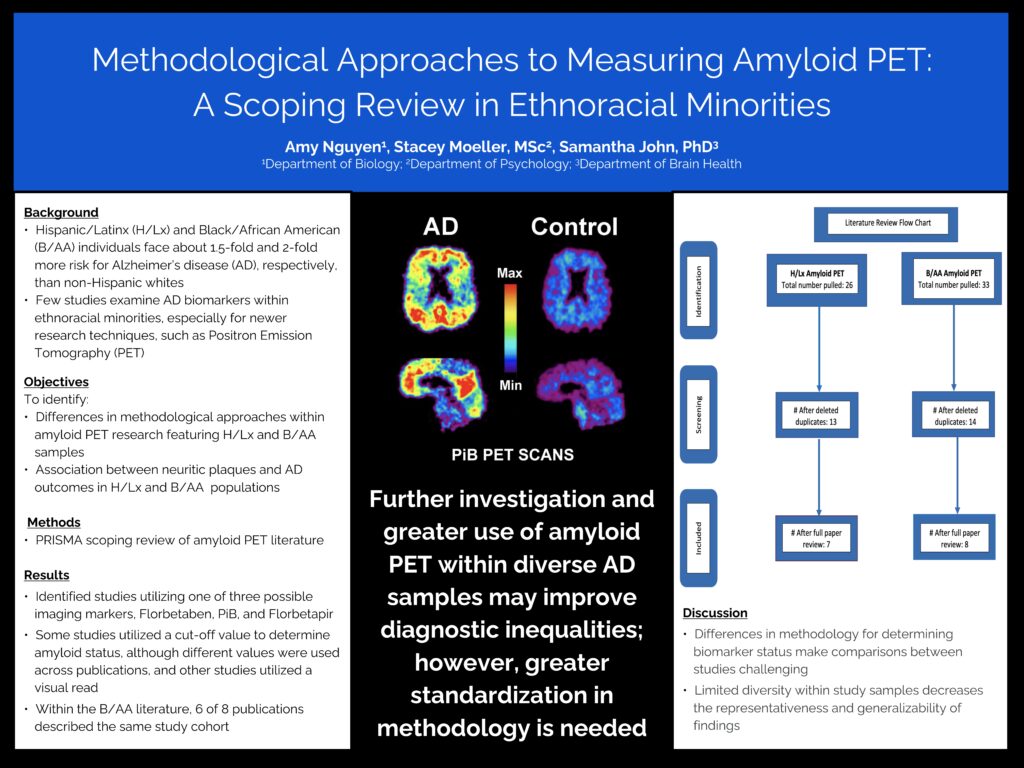HNSE-P5-2. Methodological Approaches to Measuring Amyloid PET: A Scoping Review in Ethnoracial Minorities
Amy Nguyen1
Stacey Moeller1
Faculty Mentor: Samantha John, Ph.D.2
1College of Liberal Arts, Department of Psychology
2School of Integrated Health Sciences, Department of Brain Health
ABSTRACT
Alzheimer’s disease (AD) disproportionately affects Hispanic/Latinx (H/Lx) and Black/African American (B/AA) individuals, who face about 1.5-fold and 2-fold more risk of disease development, respectively, than non-Hispanic whites. Few studies examine AD biomarkers within ethnoracial minorities, especially for newer research techniques, such as Positron Emission Tomography (PET). This study reviews current literature on amyloid PET within H/Lx and B/AA populations, exploring methodological approaches. A scoping review of AD literature was conducted to identify publications with H/Lx and B/AA study samples and amyloid PET data. Two researchers combined search results from three databases, deleted duplicates, and independently reviewed publication abstracts to determine study inclusion. Descriptive trends in the literature were examined. Within amyloid PET literature, 26 articles utilizing H/Lx populations and 33 articles including B/AA populations were reviewed. Of those, 7 H/Lx articles and 8 B/AA articles met criteria for inclusion, from which methodological differences and sample effects were evaluated. Identified studies utilized one of three possible imaging markers, Florbetaben, PiB, and Florbetapir. Some studies utilized a cut-off value to determine amyloid status, although different values were used across publications, and other studies utilized a visual read. Within the B/AA literature, 6 of 8 publications described the same study cohort. Differences in methodology for determining biomarker status makes comparison between studies challenging. Limited diversity within study samples decreases the representativeness and generalizability of findings. Further investigation and greater use of amyloid PET within diverse AD samples may improve diagnostic inequalities; however, greater standardization in methodology is needed.
Speakers
-
Amy Nguyen | College of Sciences
-
Dr. Samantha John | School of Integrated Health Sciences
-
Stacey Moeller | College of Liberal Arts



Hey Amy,
I never realized how the research on Alzheimer’s has been so limited to mainly white subjects! As you mentioned the Latino population is rapidly growing, as well as many other ethnicities! This lack of research on minorities is actually quite freighting as we don’t know how common Alzheimer’s is in these groups but most importantly how differently it affects each race! As we approach a nation of elder minorities we might not have all the answers if we don’t start diversifying our research now! The eligibility portion of the exams should definitely be more inclusive and aim to try and study a variety of races as it will benefit this nation’s elders in the future. Overall, Great poster presentation!
Hello everyone! Thank you for viewing my presentation and please feel free to leave comments or feedback. Cheers!